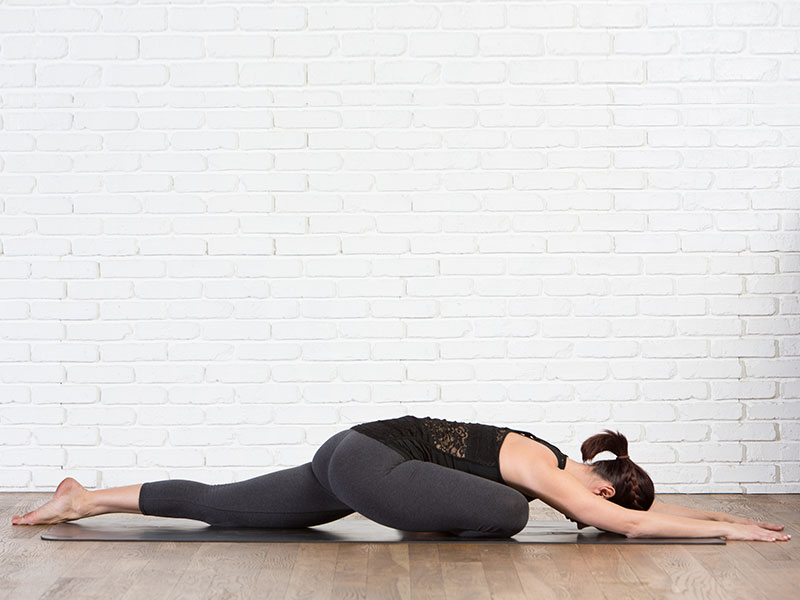Yoga is a proven method of loosening stiff muscles. It not only helps in strengthening the ones which have been weakened due to inactivity but also helps in tightening muscles. Wanna know about one of the best yoga positions for tight hips?
It’s the Pigeon pose! The Pigeon pose assists in opening up the hips because most people suffer from stiff hips. This position was actually designed to be a backbend with innumerable variations to choose from.
The sleeping variation was added to it, which gave birth to the Sleeping Pigeon pose. You must not just try the Sleeping Pigeon pose yet before getting to know how to do a Pigeon pose.
Once you’ve learned it, the Sleeping Pigeon pose would just be a step away.
MEANING
Eka Pada Rajakapotasana
Eka = one + Pada = foot or leg + Raja = king + kapota = pigeon + asana = pose
One-Legged King Pigeon Pose with the forward bend variation gave birth to the Sleeping Pigeon pose.
Now the Sleeping Pigeon pose is a type of yoga position which gives a deep and powerful stretch to your hips. If you are switching from the Pigeon pose to the sleeping one, then you would certainly feel the increase in both the intensity as well as the relaxation of the position.
The Sleeping variation helps in taking a basic hip-stretching position and finally adds a deeper sensation to the stretch when you lower your chest down in order to rest over the stretching leg.
While the Sleeping Pigeon pose can do wonders, many people do not understand it’s proper alignment, which can compromise the safety of one’s knees and SI joints.
RELATED: Health Benefits of Yoga
BENEFITS OF THE FORWARD PIGEON POSE
The basic benefit of this pose is that it provides external rotation and flexion required by your hips in order to remain agile and also releases tension from your hips from sitting around all day long.
Yoga does a lot to help us, but when you have specific requirements, then you need specific collections of the yoga booklet. The collection we are talking about is the hip-opener collection.
This yoga position helps in hip muscles and works your front legs into an external rotation while stretching the psoas muscle, which connects the groin to the lumbar spine in your back leg.
It is the perfect position for people who work at a desk all day as a regular practice of this position could give you a lot of ease in your lower body while sitting, walking, running and standing.
You have to be careful while practicing the Sleeping Pigeon Yoga as thoughtless and careless stretching can dump a lot of unwanted stress onto your knees and sacrum.
READ MORE: What is the Best Time to Do Yoga?
HOW TO MASTER THE SLEEPING PIGEON POSE?
Now let’s take a look at the four super easy tips to follow for mastering the Sleeping Pigeon pose –
Ease into the Position
To begin with, you will have to ease into the position. Let’s take it slow and step by step so that you could properly adjust to it and neither get hurt.
Begin with positioning into the Downward Facing Dog, then stretch your right leg behind you and finally bring the knee up in order to replace your right hand.
You need to maintain a 45-degree angle from your right hip to the knee.
Now it is more than likely that your shin is not yet parallel to the front of the mat. Do not worry, for you will get there eventually but with time and patience.
Your heel will be close to your body, and the top of your left foot must rest on the land behind you with your toes reaching straight back in order to avoid the sickling of your ankle.
Finally, meltdown your hips to the ground and try not to dump all your body weight on to the right side of your body.
At this point, you could either choose to stay there or extend your arms and chest to the ground in front of you for a more intense stretch.
In order to completely enjoy and experience the Sleeping Pigeon pose, keep your spine long versus rounding.
READ MORE: What to Wear to a Hot Yoga Class?
Use the Core Muscles to Square Your Torso
Now, once you have attained the position, get sure you keep your hips squared to the front of the mat.
As this is not one of the twisty yoga positions, you will have to do your best to keep both your hips facing the front of the mat.
But how do you do this part? You need to engage and activate your core muscles for shifting your front hip back towards your extended leg.
Acquire Required Space
At this point, you must be able to descend a little deeper and lower into the pose. Now plant your hands firmly in front of you and use them to scooch your back leg further towards the backside of your mat.
Keep breathing and along with every breath your draw in, back out of the fold a bit to check whether you can gather just a smidge more length through your spine.
Now when you exhale, you just have to take up even more space as you fold forward.
Modify the Pose When the Need Arises
It is always okay if you require props for your support or assistance. You could either slide a yoga block or a rolled-up towel underneath your bent hip for extra support.
Seeking support or assistance is not something to be ashamed about because even experts require support at times.
It is better to seek support from some yoga block or cushion than getting hurt as protecting your body is very important.
A Few Common Mistakes Committed While Trying the Sleeping Pigeon Pose
- Do not tilt your pelvis toward your front leg, for it will negate the desired stretch.
- Do not angle your knee to the center of your yoga mat, for it could make the position of your hips uneven, which will again make you lose the desired stretch.
Conclusion
In the end, do not keep your hopes too high as the Sleeping Pigeon pose may/may not be your kind of thing. You could keep on making alignment refreshments and still not master it or even attain it in a proper way.
Trust us; it is totally fine if you do not get it right.
Do not be disappointed and consult your yoga instructor for alternatives such as the Lying Pigeon ( the pose where you’re on your back and pull your thigh towards you) or the Sucirandhasana (thread the needle).
It is okay if this is not your thing, as you could always modify or even skip a pose altogether.




